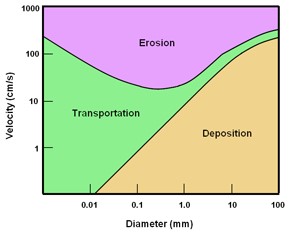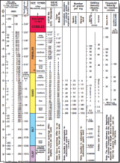
Origin and Classification of Marine Sediment
The Origins of Marine Sediment
 Sediments are everywhere in the ocean and they come from a number of processes. In this interactivity, explore where the sediments originate. Click the player button to get started.
Sediments are everywhere in the ocean and they come from a number of processes. In this interactivity, explore where the sediments originate. Click the player button to get started.
View a printable version of this interactivity.
Classifying Marine Sediment
Sediment comes from material that has been broken down by some process into smaller pieces. Does that mean that all sediments look and feel the same? Of course not. If you have been to different beaches, you know that some have nice, soft sand that feels great when you are walking barefoot, while some have sand that feels almost like gravel. Scientists have devised different methods for classifying sediments based primarily on size and location. They also have scales for comparing grain sizes regardless of the type of sediment. Size is important because it generally determines how much the ocean and its currents will be able to move sediment, a process known as erosion. Scientists and engineers study erosion to see how it affects the coastlines. This is important since the majority of people in the world live on or near a coastline.
The Wentworth Scale
Many scientists use the Wentworth scale, as seen in the image on the right, to classify sediment based on grain size. Grain size is determined by measuring the diameter of each individual particle of weathered material. The Wentworth scale classifies the largest grains as boulders, and the smallest as clay. When you think of a boulder, you might imagine a huge rock, but in this scale, boulders range from two-and-one-half inches to about ten inches. The grain sizes from largest to smallest are boulder, cobble, pebble, granule, sand, silt, and clay.
The Hjulstrom Diagram
 Scientists have created a diagram that predicts when a current of water will pick up (erode), carry (transport), and drop (deposit) a sediment based on the speed of the current and the size of the sediment. It is called the Hjulstrom diagram. The larger the particle, the higher the velocity of the water needs to be in order for it to transport the particle. The reverse is true for small particles which can be transported by currents with low velocities. However, smaller particles are very compact and cohesive so they tend to stick together really well. It takes a relatively high velocity of water to erode them in the first place, but once eroded, they stay suspended for much longer than larger particles.
Scientists have created a diagram that predicts when a current of water will pick up (erode), carry (transport), and drop (deposit) a sediment based on the speed of the current and the size of the sediment. It is called the Hjulstrom diagram. The larger the particle, the higher the velocity of the water needs to be in order for it to transport the particle. The reverse is true for small particles which can be transported by currents with low velocities. However, smaller particles are very compact and cohesive so they tend to stick together really well. It takes a relatively high velocity of water to erode them in the first place, but once eroded, they stay suspended for much longer than larger particles.
Origin and Classification of Marine Sediment Review

![]() Now that you have learned where sediments come from and how to classify them, review your knowledge. In this non-graded interactivity, read each question and select the correct response. Click SUBMIT to check your response. Click the player button to begin.
Now that you have learned where sediments come from and how to classify them, review your knowledge. In this non-graded interactivity, read each question and select the correct response. Click SUBMIT to check your response. Click the player button to begin.



